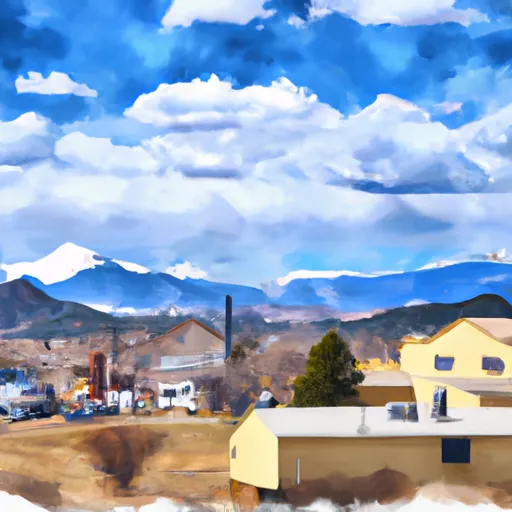-
 Snoflo Premium
Snoflo Premium
Get unlimited access to all our content
With no Ad interruptions! - Start Your Free Trial Login with existing account
South-Fork
Eden Index
Climate
6.1
•
Recreation
6.1
•
Community
•
Safeguard
4.6/10

South Fork, Colorado, is a small town nestled in the scenic San Juan Mountains. Known for its stunning natural beauty and abundant outdoor recreation opportunities, South Fork has a vibrant climate and hydrology system.
South Fork enjoys a semi-arid climate, with warm summers and cold winters. The average high temperature in summer is around 80°F, while winter temperatures can drop below freezing. Precipitation is limited, with an average annual rainfall of around 10 inches and snowfall of about 50 inches.
The town is surrounded by pristine rivers and lakes, making it a paradise for avid anglers. The Rio Grande River flows through South Fork, offering excellent opportunities for trout fishing. The nearby Rio Grande National Forest provides countless trails for hiking, mountain biking, and wildlife viewing. Outdoor enthusiasts can also enjoy activities such as camping, horseback riding, and off-roading in the surrounding mountains.
In addition to outdoor activities, South Fork hosts various events and festivals throughout the year, including music concerts, art shows, and rodeos. The town's charming atmosphere, coupled with its stunning natural surroundings, makes it an ideal destination for those seeking adventure and relaxation in the heart of Colorado.
What is the Eden Index?
The Snoflo Eden Index serves as a comprehensive rating system for regions, evaluating their desirability through a holistic assessment of climate health, outdoor recreation opportunities, and natural disaster risk, acknowledging the profound impact of these factors on livability and well-being.
Climate Health Indicator (CHI): 6.1
South-Fork receives approximately
342mm of rain per year,
with humidity levels near 69%
and air temperatures averaging around
4°C.
South-Fork has a plant hardyness factor of
5, meaning
plants and agriculture in this region thrive during a short period during spring and early summer. Most
plants will die off during the colder winter months.
By considering the ideal temperature range, reliable water supplies, clean air, and stable seasonal rain or snowpacks, the Climate Health Indicator (CHI) underscores the significance of a healthy climate as the foundation for quality living.
A healthy climate is paramount for ensuring a high quality of life and livability in a region, fostering both physical well-being and environmental harmony. This can be characterized by ideal temperatures, reliable access to water supplies, clean air, and consistent seasonal rain or snowpacks.
Weather Forecast
Streamflow Conditions
Rio Grande Headwaters
Area Rivers
Rio Grande Headwaters
Snowpack Depths
Rio Grande Headwaters
Reservoir Storage Capacity
Rio Grande Headwaters
Groundwater Levels
Recreational Opportunity Index (ROI): 6.1
The Recreational Opportunity Index (ROI) recognizes the value of outdoor recreational options, such as parks, hiking trails, camping sites, and fishing spots, while acknowledging that climate plays a pivotal role in ensuring the comfort and consistency of these experiences.
Access to outdoor recreational opportunities, encompassing activities such as parks, hiking, camping, and fishing, is crucial for overall well-being, and the climate plays a pivotal role in enabling and enhancing these experiences, ensuring that individuals can engage in nature-based activities comfortably and consistently.
Camping Areas
| Campground | Campsites | Reservations | Toilets | Showers | Elevation |
|---|---|---|---|---|---|
| Stone Cellar | 5 | 9,476 ft | |||
| Trujillo Meadows | 50 | 10,146 ft | |||
| Lake Fork | 20 | 9,510 ft | |||
| Conejos | 15 | 8,778 ft | |||
| Needle Creek Reservoir | None | 8,889 ft | |||
| Spectacle Lake | 24 | 8,763 ft | |||
| Buffalo Pass | 24 | 9,125 ft | |||
| Poso | 11 | 8,871 ft | |||
| Storm King | 11 | 9,352 ft | |||
| Luders Creek | 6 | 10,043 ft |
Nearby Ski Areas
Catastrophe Safeguard Index (CSI):
The Catastrophe Safeguard Index (CSI) recognizes that natural disaster risk, encompassing floods, fires, hurricanes, and tornadoes, can drastically affect safety and the overall appeal of an area.
The level of natural disaster risk in a region significantly affects safety and the overall livability, with climate change amplifying these risks by potentially increasing the frequency and intensity of events like floods, fires, hurricanes, and tornadoes, thereby posing substantial challenges to community resilience and well-being.
Community Resilience Indicator (CRI):
The Community Resilience Indicator (CRI) recognizes that education, healthcare, and socioeconomics are crucial to the well-being of a region. The CRI acknowledges the profound impact of these elements on residents' overall quality of life. By evaluating educational resources, healthcare accessibility, and economic inclusivity, the index captures the essential aspects that contribute to a thriving community, fostering resident satisfaction, equity, and social cohesion.

